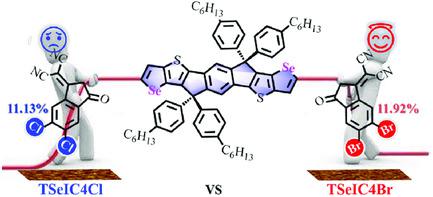Our official English website, www.x-mol.net, welcomes your
feedback! (Note: you will need to create a separate account there.)
Tetrabromination versus Tetrachlorination: A Molecular Terminal Engineering of Nonfluorinated Acceptors to Control Aggregation for Highly Efficient Polymer Solar Cells with Increased Voc and Higher Jsc Simultaneously
Solar RRL ( IF 6.0 ) Pub Date : 2020-06-23 , DOI: 10.1002/solr.202000212 Chao Zhang 1 , Tao Liu 2 , Jin-Liang Wang 1 , Kai-Kai Liu 1 , Can Yang 1 , Han-Jian Zhang 1 , Ruijie Ma 2 , He Yan 2
Solar RRL ( IF 6.0 ) Pub Date : 2020-06-23 , DOI: 10.1002/solr.202000212 Chao Zhang 1 , Tao Liu 2 , Jin-Liang Wang 1 , Kai-Kai Liu 1 , Can Yang 1 , Han-Jian Zhang 1 , Ruijie Ma 2 , He Yan 2
Affiliation

|
Herein, a pair of tetrahalogenated nonfullerene small molecular acceptors (NF‐SMAs) (TSeIC4Cl and TSeIC4Br) are designed and synthesized, with the same indacenodithieno[3,2‐b]selenophene central unit and two different dihalogenation terminal groups, respectively. The systematic investigation is achieved to reveal the impact of two different nondifluorinated terminal groups on the device performance of the resultant ITIC series NF‐SMAs. TSeIC4Br shows red‐shifted absorption range and higher frontier energy levels compared with that of TSeIC4Cl. Moreover, PM6:TSeIC4Br blend film exhibits more suitable phase‐separated morphology with more ordered molecular packing and improved miscibility compared with that of the tetrachlorinated counterpart. Importantly, PM6:TSeIC4Br‐based device exhibits a better power conversion efficiency (PCE) of 11.92%, with a higher open‐circuit voltage (Voc) and an enhanced short‐circuit current density (Jsc) when compared with that of PM6:TSeIC4Cl‐based device (11.13%). Furthermore, the energy loss can be reduced by replacing the disubstituents of end group from chlorine to bromine atoms. The results demonstrate that incorporation of indacenodithieno[3,2‐b]selenophene and replacement of tetrachlorination by tetrabromination on the end group contributes to elevating the Jsc, reduce energy loss, and enhancing the PCE for its relevant ITIC series device simultaneously, which may give a new avenue for achieving high‐performance multihalogenated ITIC series NF‐SMAs.
中文翻译:

四溴化与四氯化:非氟化受体的分子末端工程,可同时控制具有增加的Voc和更高的Jsc的高效聚合物太阳能电池的聚集
本文设计并合成了一对四卤代非富勒烯小分子受体(NF- SMAs)(TSeIC4Cl和TSeIC4Br),分别具有相同的茚并二噻吩并[3,2-b]硒烯中心单元和两个不同的二卤代末端基团。进行了系统研究,揭示了两个不同的非二氟末端基团对所得ITIC系列NF-SMA设备性能的影响。TSeIC4Br与相比示出红移吸收范围和更高的前沿能级TSeIC4Cl。此外,PM6:TSeIC4Br与四氯化膜相比,共混膜表现出更合适的相分离形态,分子堆积更加有序,并且具有更好的混溶性。重要的是,PM6:TSeIC4Br为基础的设备的展品11.92%更好的功率转换效率(PCE),具有较高的开路电压(V OC)和增强的短路电流密度(Ĵ SC)当与比较PM6 :TSeIC4Cl基于设备(11.13%)。此外,可以通过将端基的取代基从氯原子替换为溴原子来减少能量损失。结果表明,在末端基团中引入茚达双二硫杂[3,2-b]硒吩并通过四溴化取代四氯化取代有助于提高J sc,减少能量损失并同时增强其相关ITIC系列设备的PCE,这可能为实现高性能多卤代ITIC系列NF-SMA提供了新途径。
更新日期:2020-06-23
中文翻译:

四溴化与四氯化:非氟化受体的分子末端工程,可同时控制具有增加的Voc和更高的Jsc的高效聚合物太阳能电池的聚集
本文设计并合成了一对四卤代非富勒烯小分子受体(NF- SMAs)(TSeIC4Cl和TSeIC4Br),分别具有相同的茚并二噻吩并[3,2-b]硒烯中心单元和两个不同的二卤代末端基团。进行了系统研究,揭示了两个不同的非二氟末端基团对所得ITIC系列NF-SMA设备性能的影响。TSeIC4Br与相比示出红移吸收范围和更高的前沿能级TSeIC4Cl。此外,PM6:TSeIC4Br与四氯化膜相比,共混膜表现出更合适的相分离形态,分子堆积更加有序,并且具有更好的混溶性。重要的是,PM6:TSeIC4Br为基础的设备的展品11.92%更好的功率转换效率(PCE),具有较高的开路电压(V OC)和增强的短路电流密度(Ĵ SC)当与比较PM6 :TSeIC4Cl基于设备(11.13%)。此外,可以通过将端基的取代基从氯原子替换为溴原子来减少能量损失。结果表明,在末端基团中引入茚达双二硫杂[3,2-b]硒吩并通过四溴化取代四氯化取代有助于提高J sc,减少能量损失并同时增强其相关ITIC系列设备的PCE,这可能为实现高性能多卤代ITIC系列NF-SMA提供了新途径。











































 京公网安备 11010802027423号
京公网安备 11010802027423号